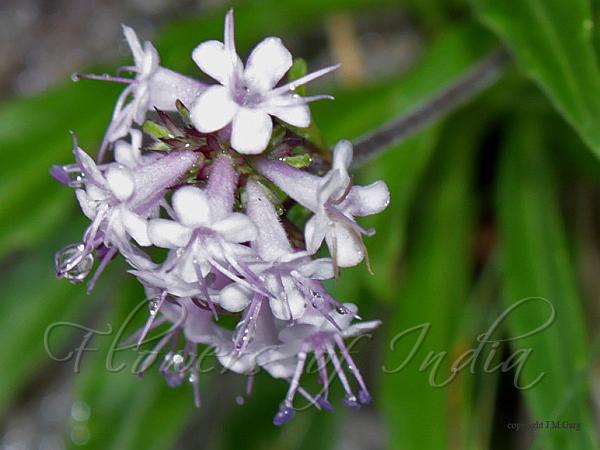|
| Spikenard |
|

|

| File size | 124330 |
| Original date | 8/13/10 2:15 PM |
| Resolution | 772 x 600 |
| Flash | Flash fired |
| Focal length | 55.0mm |
| Exposure time | 1/60s |
| Aperture | 7.1 |
| Focus Distance | |
| Metering Mode | Multi-segment |
| Camera make | Canon |
| Camera model | Canon EOS 500D |
| Sensor type |
|
|
|
|
Photo: |
Botanical name: Nardostachys jatamansi Family: Caprifoliaceae (Honeysuckle family)
Synonyms: Valeriana jatamansi D.Don, Nardostachys grandiflora, Nardostachys chinensis
Synonyms: Valeriana jatamansi D.Don, Nardostachys grandiflora, Nardostachys chinensis
Spikenard is one of the most attractive alpine plants,
unfortunately rare, with rose-purple to whitish flowers in dense heads
borne in branch-end clusters which are often branched. The whole plant
has a very distinctive and lingering smell. Flower-tube is variable
6-20 mm, with 5 rounded petals spreading to 1.2 cm or more; sepal-cup
is colored, 5-lobed, the sepals enlarging in fruit and becoming papery.
Leaves are elliptic-lanceshaped or spoon-shaped, 5-20 cm, mostly basal
and arising from the spindle-shaped rootstock which is covered with the
dark fibres of old leaves. Flowering stem is 5-30 cm. Fruit is obovate,
flattened, 1-seeded. The Spikenard is known since ancient times, a
favorite perfume. Spikenard is found on rocks, ledges, open slopes, in
the Himalayas, from Uttarakhand to SW China, at altitudes of 3600-4800
m.
Flowering: June-August.
Medicinal uses: The root-is an excellent
substitute for Valerian, and is used in many medicinal
treatments, while the oil obtained from the root is used in many
medicinal preparations and is well known as a hair tonic. Nard oil is
used as a perfume, an incense, a sedative, and an herbal medicine said
to fight insomnia, birth difficulties, and other minor ailments.
The root-is an excellent
substitute for Valerian, and is used in many medicinal
treatments, while the oil obtained from the root is used in many
medicinal preparations and is well known as a hair tonic. Nard oil is
used as a perfume, an incense, a sedative, and an herbal medicine said
to fight insomnia, birth difficulties, and other minor ailments.
Medicinal uses:
 The root-is an excellent
substitute for Valerian, and is used in many medicinal
treatments, while the oil obtained from the root is used in many
medicinal preparations and is well known as a hair tonic. Nard oil is
used as a perfume, an incense, a sedative, and an herbal medicine said
to fight insomnia, birth difficulties, and other minor ailments.
The root-is an excellent
substitute for Valerian, and is used in many medicinal
treatments, while the oil obtained from the root is used in many
medicinal preparations and is well known as a hair tonic. Nard oil is
used as a perfume, an incense, a sedative, and an herbal medicine said
to fight insomnia, birth difficulties, and other minor ailments. | Identification credit: Pankaj Kumar | Photographed on Ghangaria-Hemkunt route, Uttarakhand. |
• Is this flower misidentified? If yes,